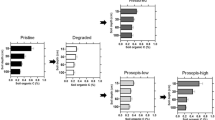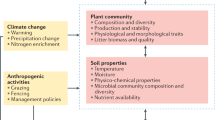Abstract
The invasion of woody vegetation into deserts, grasslands and savannas is generally thought to lead to an increase in the amount of carbon stored in those ecosystems. For this reason, shrub and forest expansion (for example, into grasslands) is also suggested to be a substantial, if uncertain, component of the terrestrial carbon sink1,2,3,4,5,6,7,8,9,10,11,12,13,14. Here we investigate woody plant invasion along a precipitation gradient (200 to 1,100 mm yr-1) by comparing carbon and nitrogen budgets and soil δ13C profiles between six pairs of adjacent grasslands, in which one of each pair was invaded by woody species 30 to 100 years ago. We found a clear negative relationship between precipitation and changes in soil organic carbon and nitrogen content when grasslands were invaded by woody vegetation, with drier sites gaining, and wetter sites losing, soil organic carbon. Losses of soil organic carbon at the wetter sites were substantial enough to offset increases in plant biomass carbon, suggesting that current land-based assessments may overestimate carbon sinks. Assessments relying on carbon stored from woody plant invasions to balance emissions may therefore be incorrect.
This is a preview of subscription content, access via your institution
Access options
Subscribe to this journal
Receive 51 print issues and online access
$199.00 per year
only $3.90 per issue
Buy this article
- Purchase on Springer Link
- Instant access to full article PDF
Prices may be subject to local taxes which are calculated during checkout



Similar content being viewed by others
References
Schlesinger, W. H. et al. Biological feedbacks in global desertification. Science 247, 1043–1048 (1990)
Vitousek, P. M., Mooney, H. A., Lubchenco, J. & Melillo, J. M. Human domination of Earth's ecosystems. Science 277, 494–499 (1997)
Schimel, D. S. et al. Recent patterns and mechanisms of carbon exchange by terrestrial ecosystems. Nature 414, 169–172 (2001)
Turner, B. L. II et al. (eds) in The Earth as Transformed by Human Action (Cambridge Univ. Press, Cambridge, 1990)
Tucker, C. J., Dregne, H. E. & Newcomb, W. W. Expansion and contraction of the Sahara Desert from 1980 to 1990. Science 253, 299–301 (1991)
Scholes, R. J. & Archer, S. R. Tree-grass interactions in savannas. Annu. Rev. Ecol. Syst. 28, 517–544 (1997)
Brown, J. H., Valone, T. J. & Curtin, C. G. Reorganization of an arid ecosystem in response to recent climate change. Proc. Natl Acad. Sci. USA 94, 9729–9733 (1997)
Allen, C. D. & Breshears, D. D. Drought-induced shift of a forest-woodland ecotone: rapid landscape response to climate variation. Proc. Natl Acad. Sci. USA 95, 14839–14842 (1998)
Casper, B. B. & Jackson, R. B. Plant competition underground. Annu. Rev. Ecol. Syst. 28, 545–570 (1997)
Amundson, R. The carbon budget in soils. Annu. Rev. Earth Planet. Sci. 29, 535–562 (2001)
Pacala, S. W. et al. Consistent land- and atmosphere-based U.S. carbon sink estimates. Science 292, 2316–2320 (2001)
Houghton, R. A., Hackler, J. L. & Lawrence, K. T. The U. S. carbon budget: contributions from land-use change. Science 285, 574–578 (1999)
Guo, L. B. & Gifford, R. M. Soil carbon stocks and land use change: a meta analysis. Glob. Change Biol. 8, 345–360 (2002)
Fang, J. Y., Chen, A. P., Peng, C. H., Zhao, S. Q. & Longjun, C. Changes in forest biomass carbon storage in China between 1949 and 1998. Science 292, 2320–2322 (2001)
Nepstad, D. C. et al. The role of deep roots in the hydrological and carbon cycles of Amazonian forests and pastures. Nature 372, 666–669 (1994)
Van Auken, O. W. Shrub invasions of North American semiarid grasslands. Annu. Rev. Ecol. Syst. 31, 197–215 (2000)
Boutton, T. W. et al. Delta C-13 values of soil organic carbon and their use in documenting vegetation change in a subtropical savanna ecosystem. Geoderma 82, 5–41 (1998)
Jackson, R. B. et al. Belowground consequences of vegetation change and their treatment in models. Ecol. Appl. 10, 470–483 (2000)
Trumbore, S. E. Potential responses of soil organic carbon to global environmental change. Proc. Natl Acad. Sci. USA 94, 8284–8291 (1997)
Jobbágy, E. G. & Jackson, R. B. The vertical distribution of soil organic carbon and its relation to climate and vegetation. Ecol. Appl. 10, 423–436 (2000)
Post, W. M., Emanuel, W. R., Zinke, P. J. & Stangenberger, A. G. Soil carbon pools and world life zones. Nature 298, 156–159 (1982)
Batjes, N. H. Total carbon and nitrogen in the soils of the world. Eur. J. Soil Sci. 47, 151–163 (1996)
Neill, C. & Davidson, E. A. in Global Climate Change and Tropical Ecosystems (eds Lal, R., Kimble, J. M. & Stewart, B. A.) 197–211 (CRC, Boca Raton, 2000)
Wall, D. H., Adams, G. A. & Parsons, A. N. in Global Biodiversity in a Changing Environment (eds Chapin, F. S., Sala, O. E. & Huber-Sannwald, E.) 47–82 (Springer, New York, 2001)
Vitousek, P. M., Kennedy, M. J., Derry, L. A. & Chadwick, O. A. Weathering versus atmospheric sources of strontium in ecosystems on young volcanic soils. Oecologia 121, 255–259 (1999)
Burke, I. C. et al. Texture, climate, and cultivation effects on soil organic matter content in U.S. grassland soils. Soil Sci. Soc. Am. J. 53, 800–805 (1989)
Tilman, D. et al. Fire suppression and ecosystem carbon storage. Ecology 81, 2680–2685 (2000)
Archer, S., Boutton, T. W. & Hibbard, K. A. in Global Biogeochemical Cycles in the Climate System (eds Schulze, E.-D. et al.) 115–137 (Academic, San Diego, 2001)
Conant, R. T., Paustian, K. & Elliott, E. T. Grassland management and conversion to grassland: effects on soil carbon. Ecol. Appl. 11, 343–355 (2001)
Gill, R. A. et al. Nonlinear grassland responses to past and future atmospheric CO2 . Nature 417, 279–282 (2002)
Acknowledgements
We thank W. Cook, L. Giles, J. Karr, L. Mack, A. Parsons and S. Rainey for laboratory analyses, and W. H. Schlesinger, A. T. Austin, O. E. Sala and E. A. Davidson for manuscript suggestions. We also thank R. J. Ansley, H. W. Polley and many others who helped us locate sites and provide their history. This work was supported by the US National Science Foundation, NIGEC/DOE, the Inter-American Institute for Global Change Research, the Andrew W. Mellon Foundation, and the Geology Foundation of the University of Texas at Austin. This paper is a contribution to the Global Change and Terrestrial Ecosystems core project of the International Geosphere Biosphere Programme.
Author information
Authors and Affiliations
Corresponding author
Ethics declarations
Competing interests
The authors declare that they have no competing financial interests.
Rights and permissions
About this article
Cite this article
Jackson, R., Banner, J., Jobbágy, E. et al. Ecosystem carbon loss with woody plant invasion of grasslands. Nature 418, 623–626 (2002). https://doi.org/10.1038/nature00910
Received:
Accepted:
Issue Date:
DOI: https://doi.org/10.1038/nature00910
This article is cited by
-
Soil carbon in tropical savannas mostly derived from grasses
Nature Geoscience (2023)
-
Conversion of native grassland to coniferous forests decreased stocks of soil organic carbon and microbial biomass
Plant and Soil (2023)
-
Organic carbon compounds associated with deep soil carbon stores
Plant and Soil (2023)
-
Shrub encroachment increases soil organic and inorganic carbon in coastal wetlands
Journal of Soils and Sediments (2023)
-
Environmental Degradation by Invasive Alien Plants in the Anthropocene: Challenges and Prospects for Sustainable Restoration
Anthropocene Science (2022)
Comments
By submitting a comment you agree to abide by our Terms and Community Guidelines. If you find something abusive or that does not comply with our terms or guidelines please flag it as inappropriate.



